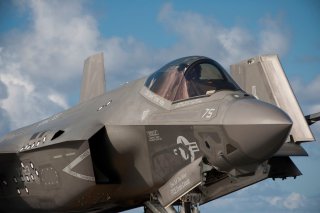6th-Generation Fighters Could Have One Ability Every Military Wants
But penetration and survivability are more than matters of fighters and flak.
Here's What You Need to Remember: That means American planes will be operating from more distant bases, and the greater distances mean fewer sorties. Which places a premium on long-range aircraft that can carry a heavy payload per sortie.
The scenario goes like this: In 2030, Russia invades the Baltic States. As the U.S. sends forces to Europe, China seizes the opportunity to seize disputed islands in the South China Sea. American airpower flies to the rescue, only to discover that sophisticated Russian and Chinese fighters and anti-aircraft defenses have rendered the skies too deadly for older American planes to conduct missions.
If this scenario were to come to pass, current U.S. air power would be unable to cope. Too many aircraft are old, have too small a range and payload, and can’t operate in tough air defense environments. One solution? Develop a sixth-generation stealth aircraft that essentially combines the air combat capability of an F-22 fighter with the electronic attack capability of an EA-18G Growler jamming aircraft.
This was the conclusion from a series of wargames conducted by the Center for Strategic and Budgetary Assessment last year. Less a prediction of the future and more a planning construct to determine what the U.S. Air Force will need twenty years from now, the Congressionally-mandated report and its underlying wargames looked at what kind of capabilities are needed for a two-front war in Europe and the Pacific.
To make U.S. airpower effective, the wargame players wanted what CSBA called a Penetrating Counter-Air/Penetrating Electronic Attack (PCA/PC-E) aircraft. “The Air Force should develop and procure a PCA/P-EA to conduct counterair, electronic attack, and other missions to defeat Russian and Chinese airborne and surface access denial systems,” the report said. “A PCA/P-EA aircraft should also have enough range, possibly 1,500 nautical miles or more, to allow integration of its operations with other long-range penetrators.”
The PCA would be both bodyguard and sheepdog, protecting older aircraft from enemy fighters and anti-aircraft defenses as they penetrate heavily defended airspace. However, Gunzinger emphasized that the PCA was not a panacea, but rather one component of a solution. “This includes weapons, unmanned systems, expendable decoys, it’s a family of capabilities,” he said.
The PCA would also have an unmanned counterpart in the form of the MQ-X, a hypothetical unmanned combat air vehicle (UCAV) that could penetrate dangerous skies to conduct counterair, electronic attack and strike. Indeed, Gunzinger noted that the study made no recommendation as to whether the PCA itself should be manned or unmanned. The study also called for penetrating surveillance drones, or P-ISR as well as more survivable air tankers.
CSBA sees the keys to successful future airpower as being penetration and survivability. If an aircraft can’t penetrate a barrier of enemy interceptors and surface-to-air missiles, then it cannot accomplish its mission. “To have the degree of freedom to operate in the battlespace is going to be so important,” Gunzinger emphasized.
But penetration and survivability are more than matters of fighters and flak. A U.S. aircraft that doesn’t have an airbase within range of the target, or even an airbase to operate from, is useless. The wargame participants wanted “longer range, larger payload systems. Because bases located close to or in future threat environments, such as Eastern Europe or the Western Pacific, they will probably be under attack or at very high risk of attack,” Gunzinger said.
“Attrition on the ground might be much higher than in the air,” he added.
That means American planes will be operating from more distant bases, and the greater distances mean fewer sorties. Which places a premium on long-range aircraft that can carry a heavy payload per sortie.
“They can’t just nibble around the edges and launch weapons over long ranges,” said Gunzinger. “But actually penetrate to deliver a variety of weapons that they can carry in large numbers.”
Michael Peck is a contributing writer for the National Interest. He can be found on Twitter and Facebook. This story was first published in April 2019.
Image: DVIDS.

